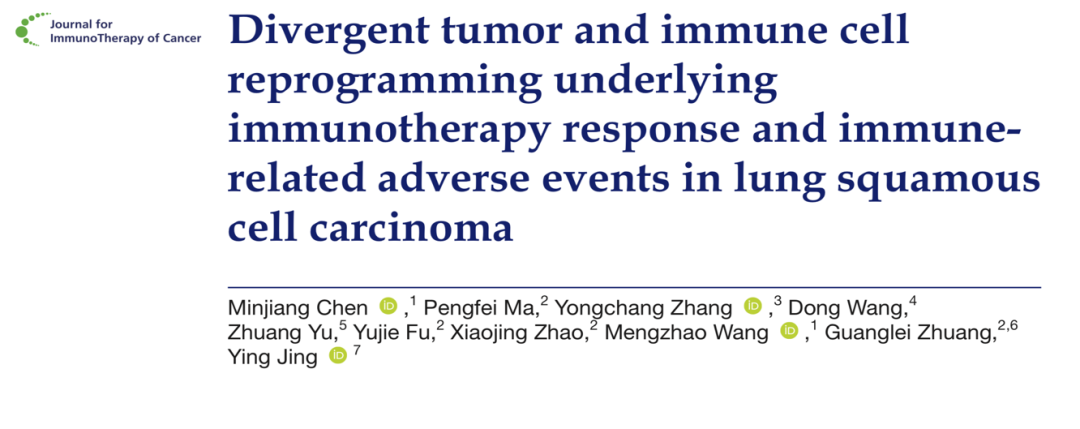Recently, the team led by Professor Wang Mengzhao, Director of the Department of Pulmonary and Critical Care Medicine at PUMCH, conducted a study in collaboration with the Greater Bay Area Institute of Precision Medicine (Guangzhou) and Renji Hospital, affiliated with Shanghai Jiao Tong University School of Medicine. Their research was published as an original research article in the “Journal for Immunotherapy of Cancer” (JCR Q1, IF=10.9). The team performed single-cell RNA sequencing (scRNA-seq) on pre-ICI and on-ICI treatment tumor biopsies. They discovered that tumor necrosis factor (TNF) can predict the occurrence of immune-related adverse events (irAEs) in patients receiving immune checkpoint inhibitor therapy, and it is independent of tumor treatment efficacy. This finding provides a new monitoring hallmark for the safe administration of immunotherapy to patients with lung squamous cell carcinoma (LUSC) and offers new targets for managing immune-related adverse events (irAEs). This study was supported by the National High Level Hospital Clinical Research Funding.

Currently, immune checkpoint inhibitors (ICIs) are widely used to treat advanced non-small cell lung cancer and can significantly prolong patient survival. However, it’s increasingly realized that ICIs could also lead to a unique spectrum of irAEs. IrAEs are induced by overactivation of the immune system and can cause systemic damage to multiple organ systems, thus being a significant factor limiting the use of ICIs. Therefore, searching biomarkers with the potential for irAEs prediction has clinical significance.
This study focused on patients with lung squamous cell carcinoma (LUSC) receiving immune checkpoint inhibitor therapy. Using single-cell transcriptome sequencing technology, the researchers analyzed pre-ICI and on-ICI treatment tumor tissue samples to explore the molecular characteristics and changes in key cellular components within the tumor microenvironment (TME) during the treatment process. Additionally, various protein quantification platforms were used to quantitatively analyze cytokines in the plasma of patients receiving immune therapy, revealing efficacy of the immune therapy and the molecular characteristics of T cells, macrophages, and tumor cells in the TME that are associated with irAEs, as well as their interactions. The study found that the TNF signaling pathway is a specific factor associated with irAEs and explored the potential clinical value of TNF in predicting irAEs, suggesting that TNF could potentially serve as a therapeutic target for irAEs in LUSC patients.
The research results demonstrate that multiple T cell subclusters with high expression of cytotoxicity-related genes accounted for a higher percentage in the tumor tissue of patients who respond to treatment. However, there were no significant differences in the proportions of T cell subclusters among patients with irAEs. The proportions of macrophages and the expression of the TNF signaling pathway were elevated in both tumor tissues and irAE-affected tissues.

▲Single-cell characterization of the LUSC tumors pre-ICI or post-ICI therapy
Based on the aforementioned sequencing results, the authors infer that the expression level of TNF in the circulatory system of cancer patients is associated with irAEs. Using two independent sample sets and one publicly available published dataset, the team analyzed the expression levels of TNF in the plasma/serum of tumor patients before and during immune therapy. The results demonstrate that the magnitude of TNF increase in the serum of patients with irAEs after immune therapy is significantly higher than patients without irAEs. However, there was no statistically significant change in TNF levels in the serum of patients with differential treatment response before and after therapy. This finding further validates the predictive significance of TNF for irAEs.
Written by the Department of Pulmonary and Critical Care Medicine
Translated by Liu Haiyan
Reviewed by Tian Xinlun and Wang Yao
